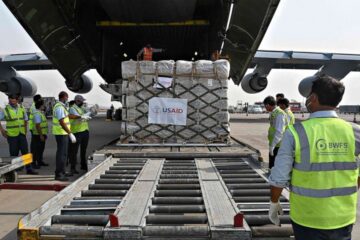Welcome back to Week 57 of my weekly reports analyzing the Covid-19 pandemic and its effects on the country and higher education. For those of you reading this on my blog, Off the Silk Road, I have also launched a newsletter, where these reports can be sent directly to your email each week. Click here to subscribe.
Last week, we discussed President Biden’s new vaccination strategy as incentives and other strategies are needed to vaccinate more Americans. This week, we will examine a major point in the pandemic with new CDC guidance as kids ages 12-15 are now eligible to be vaccinated.
A national look
Let’s start with a quick programming note: After a year researching the pandemic, I’m hitting the road. For 22 days in June, I will be traveling 4,400+ miles to 23+ cities in 17 states. On this trip, I will be documenting vaccination progress and meeting with communities as they are on the way to recovery. Through programs such as the Covid-19 Community Corps, community engagement is critical to fostering trust and boosting vaccinations. I look forward to seeing these creative strategies first-hand and talking with community leaders. Details will come soon on how you can follow the journey with reports from the field. Are you in one of these cities? Do you have destination suggestions/something I should check out? I’d love to connect with you.
After a year researching the pandemic, I’m hitting the road. For 22 days in June, I will be traveling 4,400+ miles on a road trip to 23+ cities in 17 states. On the road, I’ll be documenting vaccination progress and meeting with communities as they are on the road to recovery. pic.twitter.com/ubzzT7w1ms
— Benjy Renton (@bhrenton) May 12, 2021
That will also mean that next week will most likely be the last of my weekly newsletters (there may be a small special edition in the middle of the following week).
Vaccinations continue to have a huge impact in the U.S. A recent ABC News analysis of data from the CDC of all 50 states, Washington, D.C., and Puerto Rico found that there does indeed appear to be a correlation between the rate of vaccination in a given state and the decline in the number of new Covid-19 infections.
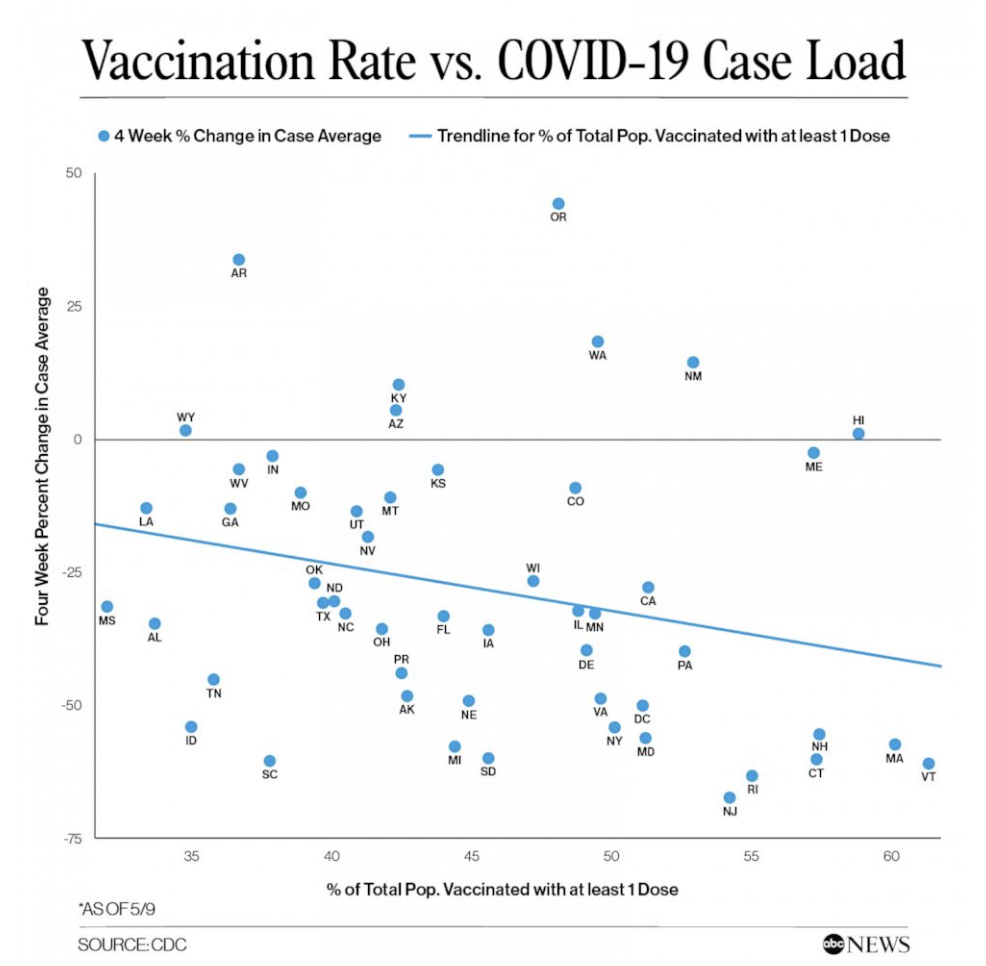
As the U.S. continues its path out of the pandemic, we must realize that the global vaccine disparities are more stark than ever. It seems that for now, the U.S. has won the battle against the variants, with the B.1.1.7 variant comprising 72% of the nation’s new cases. Much of the world’s vaccine supply continues to be used or stockpiled by countries that have already made steady progress, even as outbreaks in the developing world are raging. Outbreaks in Nepal and Singapore show us that this pandemic is not over until all of us are protected through vaccines.
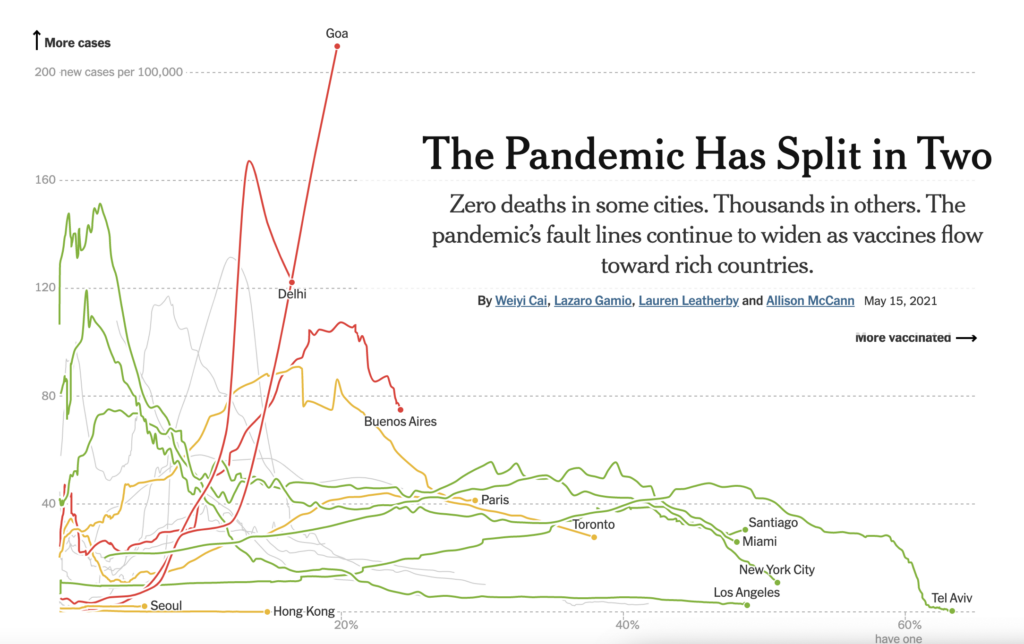
Let’s take a look at some of the latest scientific developments:
- Does recovering from Covid-19 confer protection against future infections? A new preprint says it does — researchers found a 91% lower odds of being reinfected.
- We have been hearing more about the B.1.617 variant, first discovered in India. According to a preprint, the variant is 6.8-fold more resistant to neutralization by sera from Covid-19 convalescent and Moderna and Pfizer vaccinated individuals. This is good news that the vaccines are protective. A WHO official said it is reclassifying the highly contagious triple-mutant Covid variant spreading in India as a “variant of concern” at the global level.
- The UK launched a study last week to find out whether daily Covid-19 testing could serve as a better alternative to the 10 days of self-quarantining currently required by the government’s public health agency.
- According to a new paper published in NBER, the authors found robust evidence that reopening Texas schools gradually but substantially accelerated the community spread of Covid-19. School reopenings led to at least 43,000 additional Covid-19 cases and 800 additional fatalities within the first two months.
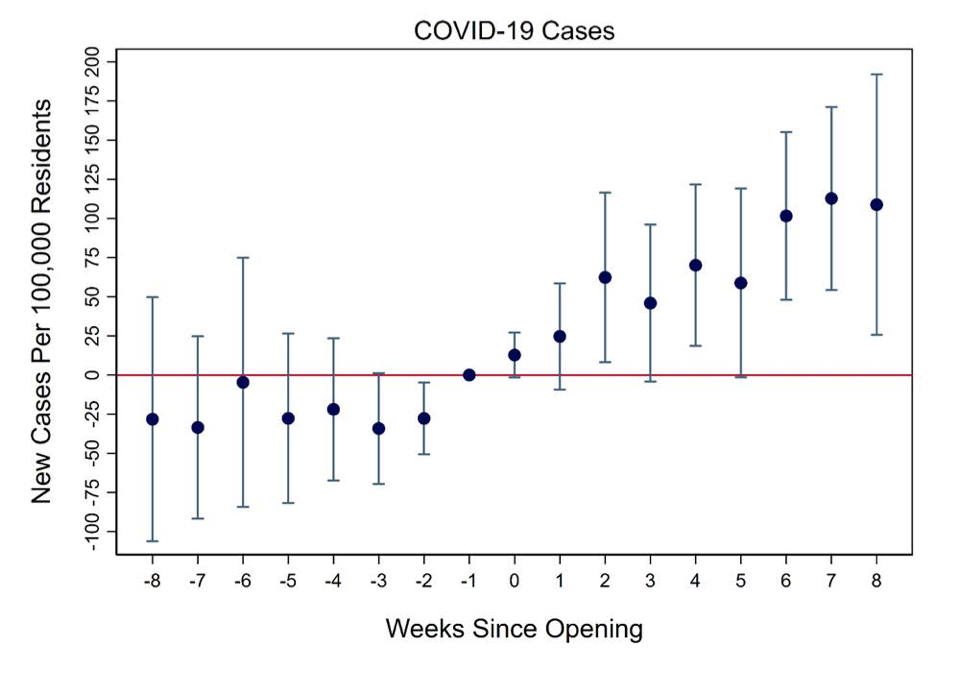
- A paper in PNAS shows that 90% of the virus load (circulating virions) is harbored by only 2% of individuals.
- Previously, the CDC has said that around 10% of transmissions occur outdoors. In truth, the share of transmission that has occurred outdoors seems to be below 1% and may be below 0.1%, multiple epidemiologists told The New York Times. The rare outdoor transmission seems to have involved crowded places or close conversation.
- The next time the world faces an outbreak of a fast-spreading and deadly new pathogen, governments must act swiftly and be ready to restrict travel or mandate masks even before anyone knows the extent of the threat, according to a pair of new reports delivered to the World Health Organization.
- A study published in The Lancet found that in a randomized control trial, there was no significant difference in 28-day mortality between the group that used convalescent plasma and the group that did not.
- The Biden administration will invest $7.4 billion from the American Rescue Plan to recruit and hire public health workers to respond to the pandemic.
This week’s biggest scientific change came from the CDC on Thursday, when mask guidance was updated for fully vaccinated individuals. “Fully vaccinated people no longer need to wear a mask or physically distance in any setting, except where required by federal, state, local, tribal, or territorial laws, rules, and regulations,” the guidance now reads.
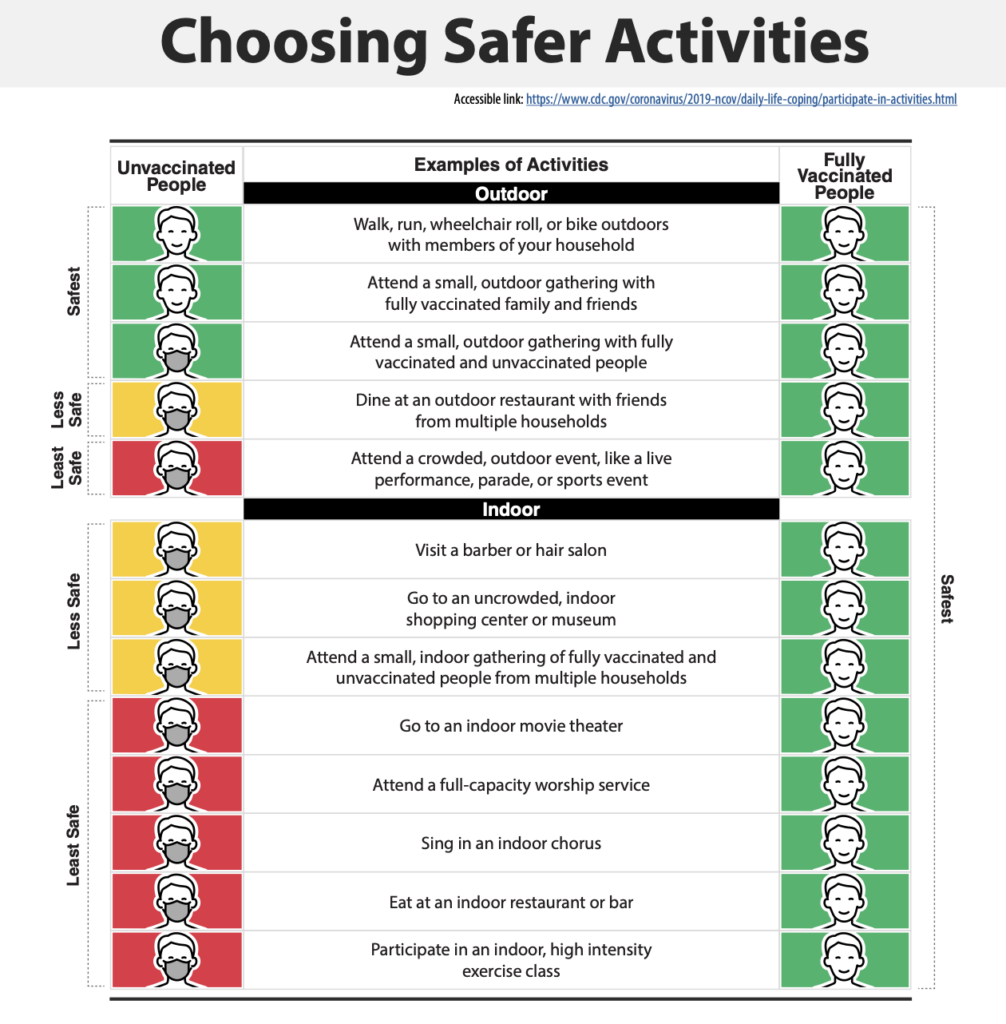
For many reasons, May 13, 2021 will be an historic day in American history — a key milestone on our way out of the pandemic and for some, a day of freedom. However, many experts have criticized the CDC’s decision. With a lack of a universal way to verify vaccination status, states and businesses are put in difficult situations and Americans are forced to rely on the honor system. This is now a question of individual health vs. population (public) health. Wide variability in vaccination rates means different risk levels across the country. As of yesterday, only 36.7% of the American population is fully vaccinated. Many of the U.S.’ largest chain stores have followed the CDC guidance already, dropping masking requirements for fully vaccinated individuals. By our count on Friday, 16 states have announced they will adapt current mask policies to align with CDC guidance. 2 states (MA and CT) will make these changes in the next week. 12 states (including DC) say they are reviewing the guidance. 21 states do not have statewide mask mandates.
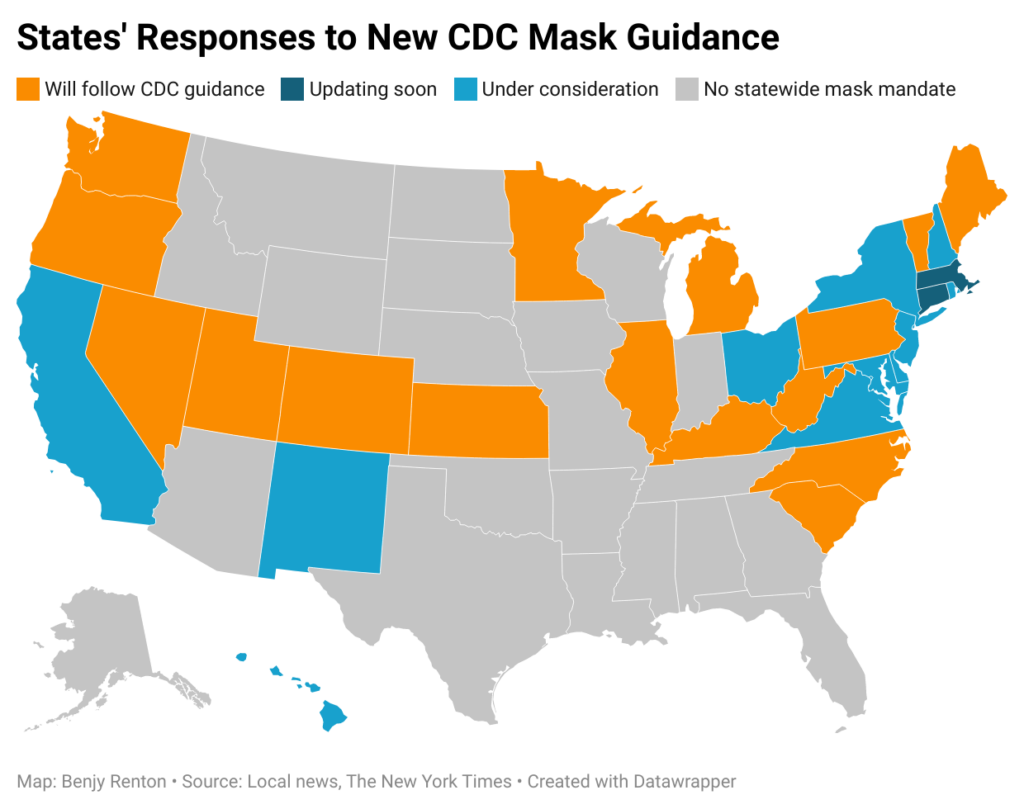
“The C.D.C. shift does not seem to fully account for the risks to the great number of unvaccinated people or the immunocompromised, especially those working indoors,” professor Zeynep Tufekci writes in The New York Times. “They’re betting–possibly correctly–that “vaccine=no more mask” will be enticing enough to ‘undecideds’ that it’ll increase rates of vaccination more than any possible increase in vaccine-breakthrough spread,” Brigham and Women’s Hospital physician Dr. Jeremy Faust writes. Here’s how I see this guidance: We knew this was coming at some point in the future. The vaccines are highly effective against preventing disease and transmission, as seen in various studies. However, with many Americans only becoming eligible on April 19, many of those individuals have not had the chance to become fully vaccinated. As I wrote in a Twitter thread on Friday, many Americans still want the vaccine but have not been able to gain access to one. We must show empathy to those who still choose to wear a mask and I do believe that the next few weeks will be filled with difficult questions and issues. As vaccinations increase, I believe we will also be more comfortable living in this new world.
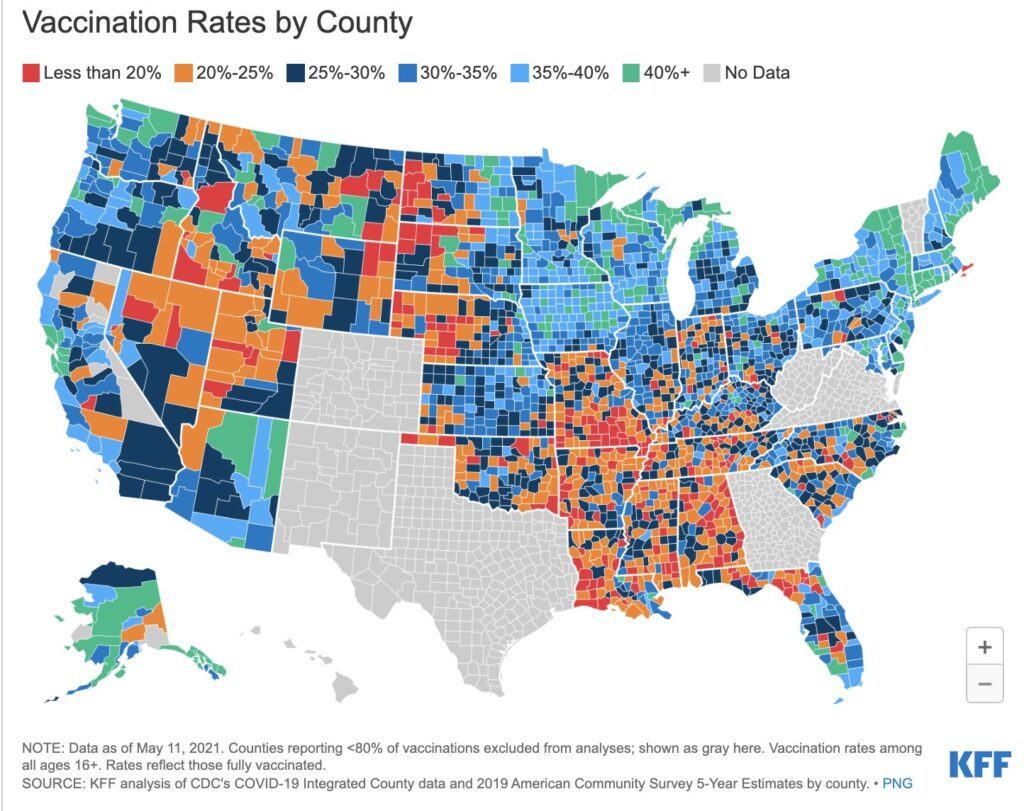
Access, access, access. The data are clear: To tackle what many perceive as “hesitancy” we must fix the structural barriers to vaccination for many Americans. As I wrote in a Twitter thread earlier this week, the latest Census Bureau data show that the percentage of unvaccinated who “will definitely” get a vaccine actually exceeds those who “will definitely not” get a vaccine. Adding together the definitely, probably and unsure, that is ~47 million people — 19% of all American adults.
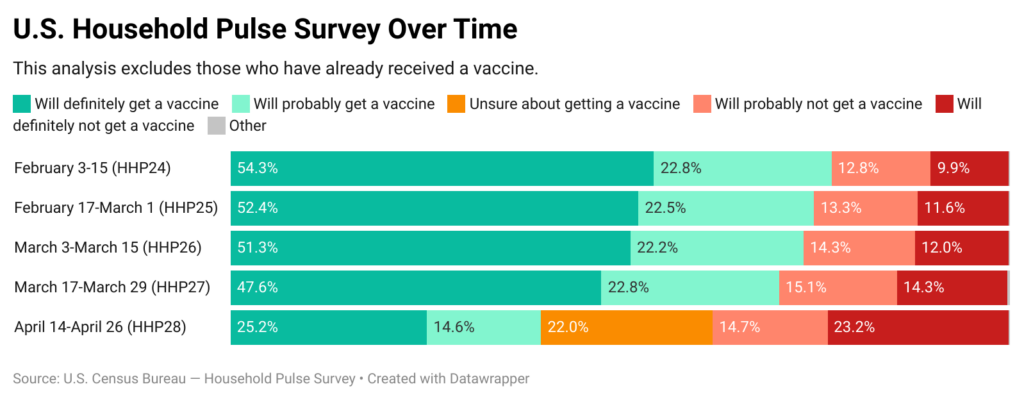
The latest CDC data by race/ethnicity actually expose one promising trend — while there is still a lag, vaccination rates are accelerating in Hispanic individuals as they flatline in white individuals.
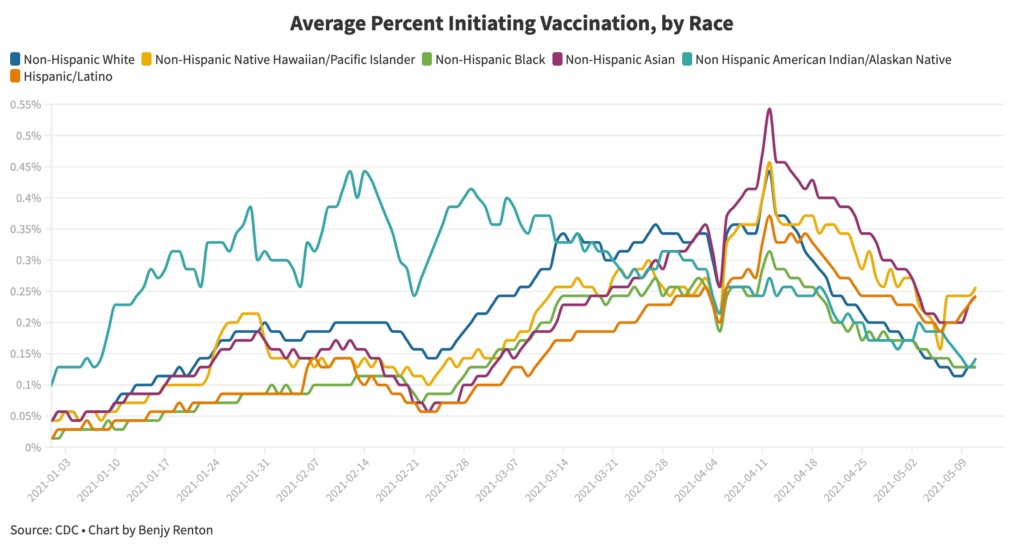
According to a Kaiser Family Foundation poll, Hispanic adults who have not yet been vaccinated are more enthusiastic than white adults to get the vaccine. Many cite barriers. We need to remove them.
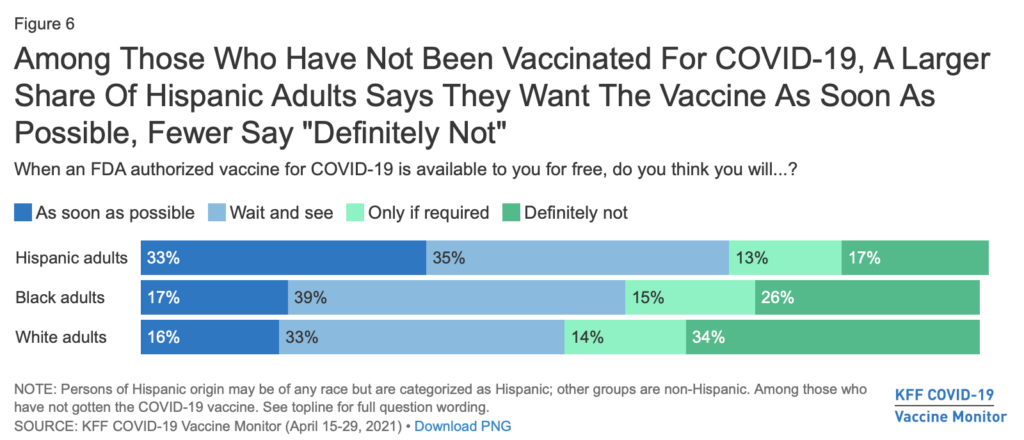
In the past few weeks, many states have seen the number of new doses delivered plummet. This is not due to a lack of supply; it is due to states ordering less because of perceived low demand. This is concerning because these states have low vaccination rates. Average new deliveries in the Northeast are now more than twice the rates in the Midwest and South.
Let’s look at two comparable states: Vermont and Wyoming. Vermont’s new doses delivered have remained constant over the past month, indicating abundant demand. Wyoming’s new doses have plummeted. Usually receiving 50,000 doses in a week, the state now only receives ~7,000. States prematurely declaring victory and ordering fewer doses will only widen the disparities in vaccination rates among states.
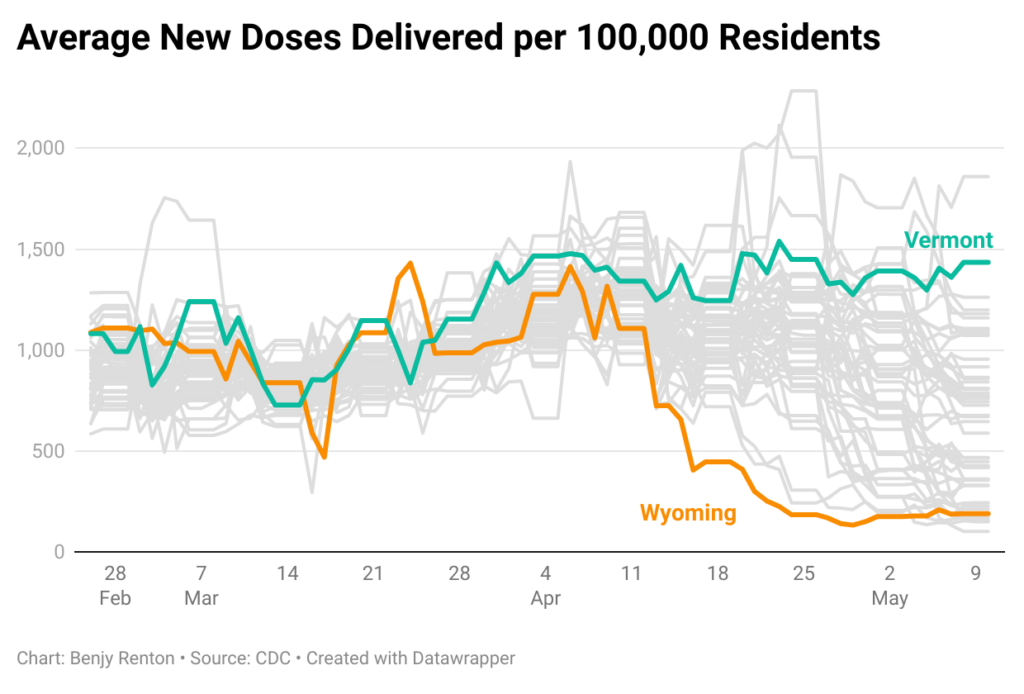
A few other updates on vaccines:
- The FDA and CDC have officially authorized the Pfizer vaccine in kids ages 12-15. This now adds 17 million more people to the pool of those eligible to be vaccinated. In the first few days, kids have been very eager to be vaccinated. A Kaiser Family Foundation analysis found that nearly half of adolescents ages 12-15 are people of color.
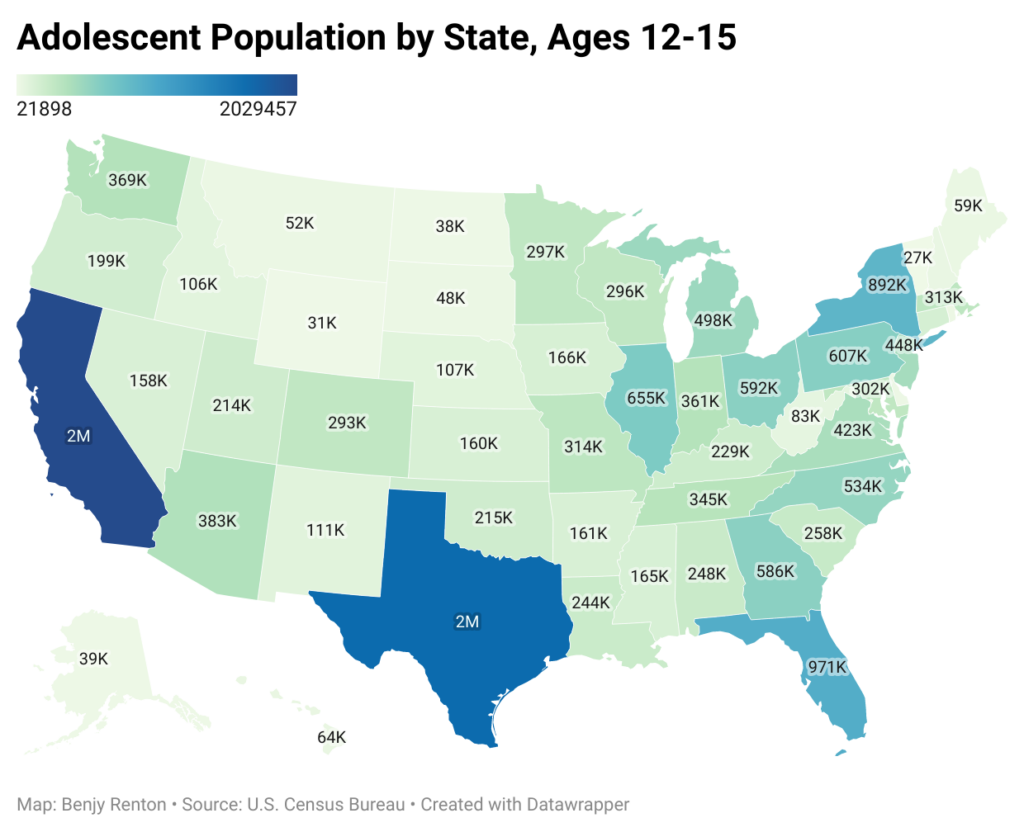
- Much discussion this week has revolved around the outbreak among Yankees players and staff, who received the Johnson & Johnson vaccine. As Brown University School of Public Health Dean Dr. Ashish Jha notes, this is a success story. We expect to see breakthrough cases and only one of these individuals is symptomatic. This is evidence the vaccine works.
- A study published in Nature shows promise for a vaccine that may work across all coronaviruses. The vaccine has a potent effect in monkey trials.
- A VaccineFinder analysis found that 78.8% of people live within 5 miles of locations that offer all 3 vaccines. “When you empower people to make decisions, I think for some people that will make a difference,” Boston Children’s Hospital epidemiologist Dr. John Brownstein said. This all comes as the White House launched a new partnership with Uber to offer free rides to vaccination sites.
- The Cleveland Clinic released a study showing that 99.75% of their patients hospitalized with Covid-19 between January 1 and April 13 were not fully vaccinated.
- According to a new CDC report, men had higher vaccination initiation rates than women, and counties with lower vaccination initiation rates had higher percentages of older adults with social vulnerabilities.
- Sinovac’s vaccine is wiping out Covid-19 among health workers in Indonesia, an encouraging sign for the dozens of developing countries reliant on the vaccine.
- This is just strange: An anti-vaccine conspiracy about the vaccinated are leading some anti-maskers and anti-vaxxers to contemplate wearing a mask and social distance.
- To the many propositions and incentives that governments have used to try to bolster slumping demand for the coronavirus vaccine, Governor Mike DeWine of Ohio raised the ante considerably, announcing a weekly lottery program where the state will give five people $1 million each in return for getting vaccinated.
- As Broadway prepares for a fall reopening, Hamilton’s producer Jeffrey Seller said he will mandate that all of his show’s employees, including the cast and the backstage crew, be vaccinated.
- Two new studies solidify evidence that the vaccines are safe for pregnant individuals. Researchers found no evidence that the Pfizer or Moderna vaccines damaged the placenta. Antibodies were also detected in the placenta and in breast milk.
- Commuter hubs are designed to attract people, and once the MTA set up a vaccination site in New York’s Grand Central Station, 100 people were vaccinated within two hours, with a total of over 1,000 in one day.
- According to poll results published in Axios, 74% of youth say people should get vaccinated before returning to campus or the office.
- Researchers have found just 12 people are responsible for the bulk of the misleading claims and outright lies about Covid-19 vaccines that proliferate on Facebook, Instagram and Twitter.
- A CNN analysis found Democratic lawmakers in both chambers of Congress have a 100% vaccination rate against Covid-19, significantly outpacing Republicans in the House and Senate and illustrating the partisan divide over the pandemic. For Republicans, at least 44.8% of House members are vaccinated and at least 92% of senators are.
- The latest data from CDC on breakthrough cases now only include those severe enough to require hospitalization or result in death. Out of 115 million people fully vaccinated, there have been 1,359 hospitalized or fatal cases and 181 Covid-related deaths.
- A new study from England suggests that delaying the second dose of the Pfizer–BioNTech mRNA vaccine could boost antibody responses after the second inoculation more than threefold in those older than 80.
- According to a new CDC report from health care workers at 33 U.S. sites, the Pfizer and Moderna vaccines are 94% effective at preventing symptomatic Covid-19 after two doses. This shows that the data are consistent with clinical trials.
- New modeling estimates Israel’s vaccination campaign has averted 158,665 infections, 24,597 hospitalizations and 5,533 deaths (91% of which are in people ≥65). 73% of infections averted have stemmed from the vaccines’ protective effects.
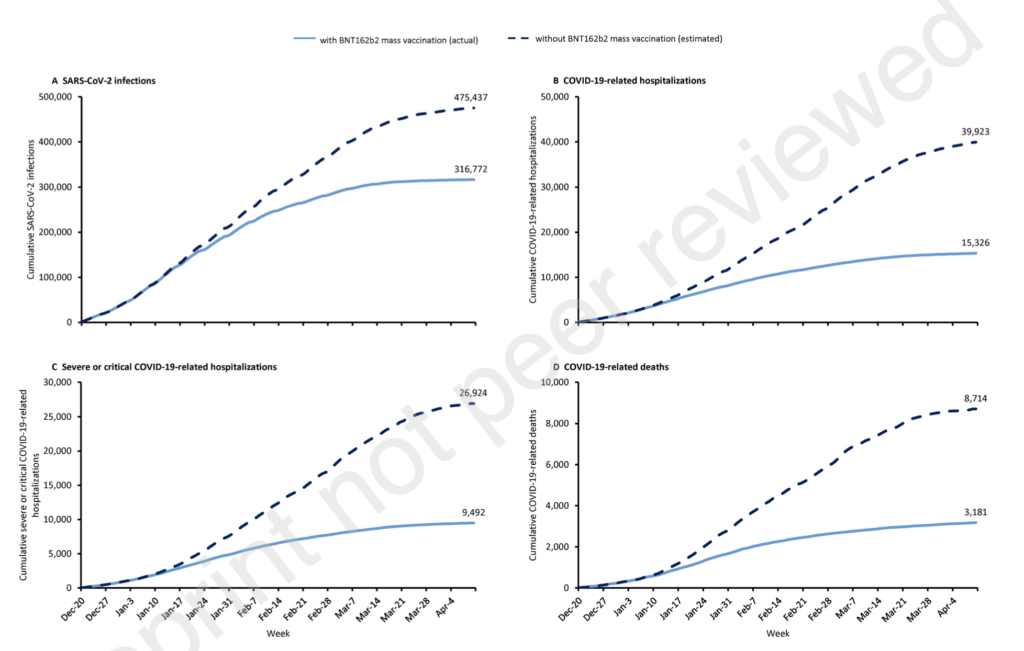
Let’s move on to our discussion of higher education.
Higher education
Here’s a roundup of this week’s higher ed news:
- Notre Dame made headlines in the fall with one of the first college outbreaks. For months, it battled surges fueled by gatherings and inadequate testing. For the first time this year, the 7-day test positivity is 0.0%. >90% of the student body is vaccinated. Vaccines work.
- The Chronicle of Higher Education has now identified 356 campuses which have announced requirements for proof of vaccination by the fall, including the State Universities of New York.
- Vaccination rates are picking up across the country, including at colleges and universities. Students and staff are still catching Covid-19, but the large spikes that characterized the fall semester are now mostly absent.
- As India continues to grapple with the world’s most devastating Covid-19 surge since the pandemic began, Dartmouth College’s Indian community has responded by organizing fundraisers and compiling numerous resources in support of those affected.
- Students at Bowdoin College reflect on living in the Brunswick Hotel for the semester.
- Many colleges, including the University of Texas at Austin, are still reevaluating the CDC guidance when it comes to their masking policies.
- As the Chronicle’s Francie Diep reports, some colleges are not requiring vaccination but will encourage it through incentives, including the lure of in-person education.
- Purdue University president Mitch Daniels entered yesterday’s commencement on the campus-renowned “couch cart.”
President Mitch Daniels entered the stadium in style, taking a ride on the campus-renowned “couch cart.” pic.twitter.com/KbndUrhrVR
— Purdue Exponent (@purdueexponent) May 15, 2021
The Good Stuff
Let’s roll the clips of the good stuff. In my usual tradition, I feature my favorite stories from the week. Here are my Top 10.
- Exactly 225 years ago Friday, on 14 May 1796, Edward Jenner applied fluid from a cowpox blister to the arm of James Phipps in the first part of an experiment that eventually proved mild cowpox infection protected against smallpox. Jenner’s technique became known as vaccination.
- Last night, CNN’s chief medical correspondent Dr. Sanjay Gupta narrated a fantastic documentary entitled “Race for the Vaccine,” which followed leading vaccine candidates throughout development and distribution. Check out the behind-the-scenes look here.
- Dr. Kizzmekia Corbett, one of the leading scientists behind the Moderna vaccine, has now been appointed to her own lab at the Harvard T.H. Chan School of Public Health.
- Vanity Fair published a fascinating article about a medical division in the State Department saving the lives of Americans all around the world and playing a key role in vaccine distribution to embassies and consulates.
- Want to know about the pets owned by members of President Biden’s cabinet? Business Insider has you covered.
- One rural Virginia town came together for a pandemic prom.
- Indian American doctors have been offering free telehealth advice during India’s Covid-19 crisis.
- The New York Times published a photo essay on the strange new life of vaccine sites and unusual vaccine locations.
- A Bengal tiger that had been missing in the Houston area has been located unharmed and is now in the city’s animal shelter.
- Huge Ma, the owner of the popular NYC vaccine search site TurboVax, announced that his website will be shutting down. We extend our gratitude to him for his ingenuity and public service.
- Bonus: Help your 12-15 year-old family members and friends sign up for a vaccine!
These sweet sisters are excited about the wonder of science, getting back to the things they love and healthier world for us all. Thank for sharing and getting vaccinated Lucy an Lily! #SleevesUpForSummer pic.twitter.com/9tlyWcGt4i
— Anne Zink (@annezinkmd) May 16, 2021
Conclusion
The CDC’s new guidance marks a critical turning point in the pandemic and one that shows vaccination is the key to normal life. However, confusion surrounding the guidance has left many Americans unsure and unprepared. These vaccines are scientific miracles and are highly effective; however, we must realize that universal access has still not yet been achieved in the U.S., never mind the world. It is up to all of us to foster empathy and equity as we navigate this new phase.
I’d like to thank all the student journalists with whom I have the pleasure of working. In the next weeks and months ahead, they will become vital in chronicling their colleges’ paths forward for the spring and beyond. Support their work by reading it.
My best to all for good health.
Like what you see? Don’t like what you see? Want to see more of something? Want to see less of something? Let me know in the comments. And don’t forget to subscribe to the weekly newsletter!
For more instant updates, follow me on Twitter @bhrenton.


